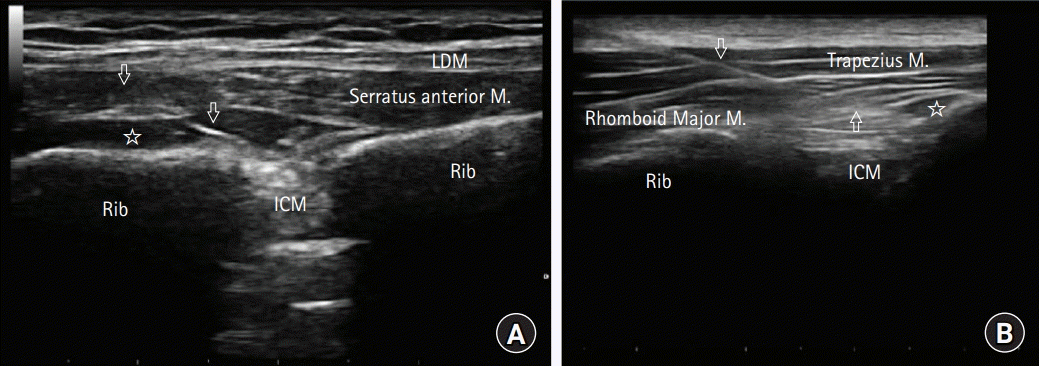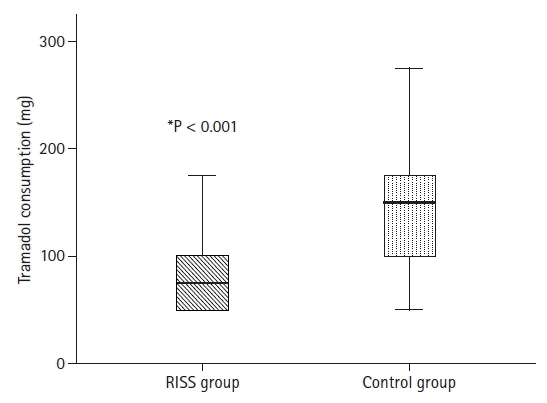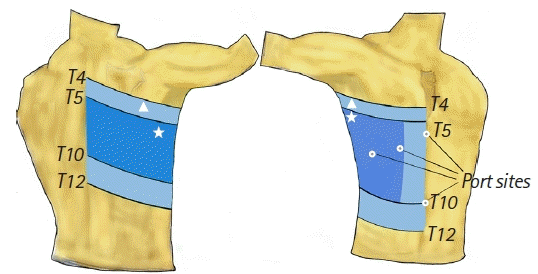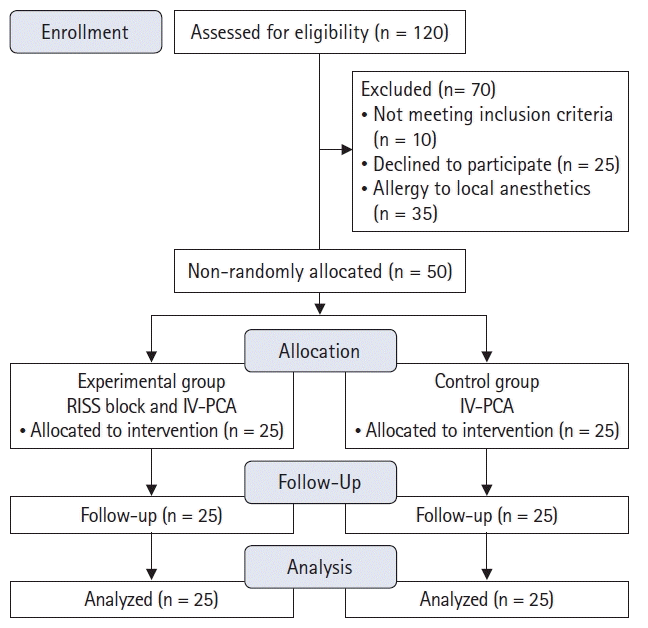1. Siddiqui NA, Azami R, Murtaza G, Nasim S. Postoperative port-site pain after gall bladder retrieval from epigastric vs. umbilical port in laparoscopic cholecystectomy: a randomized controlled trial. Int J Surg. 2012; 10:213–6.

2. Kim SS, Kim SH, Mun SP. Should subcostal and lateral trocars be used in laparoscopic cholecystectomy? A randomized, prospective study. J Laparoendosc Adv Surg Tech A. 2009; 19:749–53.

3. Bisgaard T, Klarskov B, Rosenberg J, Kehlet H. Characteristics and prediction of early pain after laparoscopic cholecystectomy. Pain. 2001; 90:261–9.

4. Børglum J, Maschmann C, Belhage B, Jensen K. Ultrasound-guided bilateral dual transversus abdominis plane block: a new four-point approach. Acta Anaesthesiol Scand. 2011; 55:658–63.

5. Ure BM, Troidl H, Spangenberger W, Dietrich A, Lefering R, Neugebauer E. Pain after laparoscopic cholecystectomy. Intensity and localization of pain and analysis of predictors in preoperative symptoms and intraoperative events. Surg Endosc. 1994; 8:90–6.
6. Elsharkawy H, Pawa A, Mariano ER. Interfascial plane blocks: back to basics. Reg Anesth Pain Med. 2018; 43:341–6.

7. Elsharkawy H, Maniker R, Bolash R, Kalasbail P, Drake RL, Elkassabany N. Rhomboid intercostal and subserratus plane block: a cadaveric and clinical evaluation. Reg Anesth Pain Med. 2018; 43:745–51.
8. Elsharkawy H, Hamadnalla H, Altinpulluk EY, Gabriel RA. Rhomboid intercostal and subserratus plane block -a case series. Korean J Anesthesiol. 2020; 73:550–6.

9. Lee IO, Kim SH, Kong MH, Lee MK, Kim NS, Choi YS, et al. Pain after laparoscopic cholecystectomy: the effect and timing of incisional and intraperitoneal bupivacaine. Can J Anaesth. 2001; 48:545–50.

10. Ökmen K, Metin Ökmen B, Topal S. Ultrasound-guided posterior quadratus lumborum block for postoperative pain after laparoscopic cholecystectomy: a randomized controlled double blind study. J Clin Anesth. 2018; 49:112–7.

11. Michaloliakou C, Chung F, Sharma S. Preoperative multimodal analgesia facilitates recovery after ambulatory laparoscopic cholecystectomy. Anesth Analg. 1996; 82:44–51.

12. Elsharkawy H, Saifullah T, Kolli S, Drake R. Rhomboid intercostal block. Anaesthesia. 2016; 71:856–7.

13. Ueshima H. Rhomboid intercostal and subserratus plane block for transapical transcatheter aortic valve implantation. J Clin Anesth. 2019; 54:146.

14. Yayik AM, Aydin ME, Tekin E, Ulas AB, Ahiskalioglu A. An alternative plane block for multiple rib fractures: rhomboid intercostal and sub-serratus block (RISS). Am J Emerg Med. 2019; 37:2263.

15. Arık E, Akkaya T, Ozciftci S, Alptekin A, Balas Ş. Unilateral transversus abdominis plane block and port-site infiltration: comparison of postoperative analgesic efficacy in laparoscopic cholecystectomy. Anaesthesist. 2020; 69:270–6.

16. Willard FH, Vleeming A, Schuenke MD, Danneels L, Schleip R. The thoracolumbar fascia: anatomy, function and clinical considerations. J Anat. 2012; 221:507–36.

17. Blanco R. The mechanism of the quadratus lumborum block: a peripheral sympathetic field block? Br J Anaesth. 2016; 117:EL_13593.

18. Yahia L, Rhalmi S, Newman N, Isler M. Sensory innervation of human thoracolumbar fascia. An immunohistochemical study. Acta Orthop Scand. 1992; 63:195–7.
19. Schilder A, Hoheisel U, Magerl W, Benrath J, Klein T, Treede RD. Sensory findings after stimulation of the thoracolumbar fascia with hypertonic saline suggest its contribution to low back pain. Pain. 2014; 155:222–31.

20. Taguchi T, Hoheisel U, Mense S. Dorsal horn neurons having input from low back structures in rats. Pain. 2008; 138:119–29.

21. Ganjaei KG, Ray JW, Waite B, Burnham KJ. The fascial system in musculoskeletal function and myofascial pain. Curr Phys Med Rehabil Rep. 2020; 8:364–72.

22. Domingo T, Blasi J, Casals M, Mayoral V, Ortiz-Sagristá JC, Miguel-Pérez M. Is interfascial block with ultrasound-guided puncture useful in treatment of myofascial pain of the trapezius muscle? Clin J Pain. 2011; 27:297–303.

23. Kongsagul S, Vitoonpong T, Kitisomprayoonkul W, Tantisiriwat N. Ultrasound-guided physiological saline injection for patients with myofascial pain. J Med Ultrasound. 2019; 28:99–103.

24. Stecco C, Stern R, Porzionato A, Macchi V, Masiero S, Stecco A, et al. Hyaluronan within fascia in the etiology of myofascial pain. Surg Radiol Anat. 2011; 33:891–6.








 PDF
PDF Citation
Citation Print
Print




 XML Download
XML Download